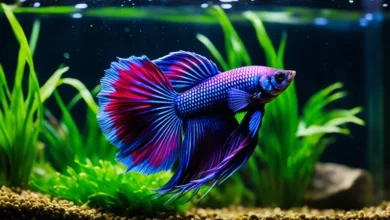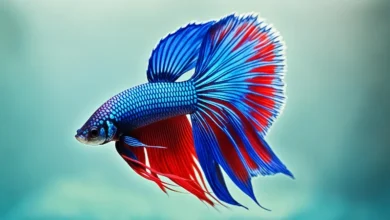
Are you a proud owner of a stunning Halfmoon Betta fish? Known for their vibrant colors and impressive tail shapes, Halfmoon Bettas are a popular choice for aquarium enthusiasts. However, caring for these majestic creatures requires specific knowledge and attention to detail.
In this article, we will delve into the essential care tips for Halfmoon Betta Fish, as well as explore the different tail types that make them truly unique. Whether you’re a long-time Betta fish owner or considering adding one to your collection, understanding the Halfmoon Betta care guidelines will ensure a healthy and thriving aquatic companion. So, let’s dive in and discover the secrets to creating an optimal environment for your Halfmoon Betta.
What is a Halfmoon Betta Fish?
A Halfmoon Betta fish is a fin variant of the Betta species. Male Halfmoons have a distinctive tail that forms a 180-degree arc, giving them their name. Female Halfmoons have smaller fins. Halfmoons come in various types and colors and are popular among both beginner and experienced aquarists.
Halfmoon Bettas are known for their unique and stunning tails. The males have tails that spread out in a perfect half circle when they flare or swim, resembling a crescent moon. This tail shape is what differentiates them from other Betta variants.
Female Halfmoons have smaller, less pronounced fins compared to the males. This allows them to swim more easily and navigate through the water with agility. While the males are visually striking with their large, flowing tails, the females have their charm.
Halfmoon Betta fish are available in a wide range of colors and patterns. From vibrant solids to mesmerizing marbles, there is a Halfmoon Betta to suit every aquarist’s taste. Some popular Halfmoon color variants include red, blue, black, white, and multicolored. They also come in stunning metallic shades and patterns like dragon scales and butterfly patterns.
Due to their unique beauty, Halfmoon Betta fish have become highly sought after in the aquarium trade. They make captivating display fish and are often the center of attention in any tank they inhabit.
Halfmoon Betta Fish Types
Halfmoon Bettas are known for their stunning and diverse tail variants and color variations. Let’s explore the different types of Halfmoon Betta fish:
Tail Variants:
- Dumbo Halfmoon.
- Rosetail Halfmoon.
- Twintail Halfmoon.
- King Halfmoon.
- Over Halfmoon.
Color Variants:
- Solid-Colored.
- Bi-Colored.
- Dragonscale.
- Marble.
- Koi.
- Mustard Gas.
- Butterfly.
Each tail variant and color variation adds a unique touch to the Halfmoon Betta’s appearance, making them truly captivating aquatic pets.
How to Take a Halfmoon Betta Fish Care
Proper care of a Halfmoon Betta fish is crucial to ensure its health and well-being. By following these tips, you can create the optimal environment for your Halfmoon Betta:
Maintaining Water Parameters
Halfmoon Bettas thrive in water with specific temperature, pH, and ammonia levels. It is important to maintain a water temperature between 76-82°F (24-28°C) for optimal health. The pH level should be maintained between 5-7.5, and ammonia levels should be regularly checked and kept at zero.
Choosing the Right Tank Size
A 10-gallon tank is recommended for a single Halfmoon Betta. These fish require ample space to swim and explore their surroundings comfortably. A larger tank also helps maintain stable water parameters and reduces the frequency of water changes.
Considering Territorial Behavior
Halfmoons are territorial fish and should be kept either alone or with compatible tank mates. Avoid housing them with aggressive or fin-nipping fish that may harm their delicate fins. Providing hiding spots and plants in the tank can help reduce stress and provide a sense of security for your Halfmoon Betta.
Feeding a High-Protein Diet
Halfmoon Bettas require a diet rich in protein to support their growth and vibrant colors. Feed them high-quality betta pellets or flakes as their staple food. Additionally, supplement their diet with live or frozen foods like brine shrimp or bloodworms to provide variety and essential nutrients.
Remember, proper care and attention to the needs of your Halfmoon Betta fish will contribute to its overall well-being and longevity. They are gorgeous creatures that can bring joy and beauty to any aquarium.
Setting Up a Tank for Halfmoon Betta Fish Care
When it comes to setting up a tank for Halfmoon Bettas, creating the right environment is crucial for their health and well-being. These majestic fish deserve a comfortable and aesthetically pleasing home that closely resembles their natural habitat. Here are some essential factors to consider when setting up a tank for your Halfmoon Betta:
Adequate Space
Halfmoon Bettas require enough space to swim and explore. A tank with a minimum capacity of 10 gallons is recommended to accommodate their active nature. Ensure that the tank size allows sufficient room for their long, flowing fins to glide gracefully through the water.
Proper Filtration
A reliable filtration system is essential for maintaining water quality in your Halfmoon Betta tank. A gentle filter with adjustable flow settings is ideal to prevent the strong water currents from damaging their delicate fins. Regularly clean and maintain the filter to ensure its optimal function.
Creating a Suitable Environment
Transform your tank into a mini underwater paradise by adding live plants and decorations that mimic their natural habitat. Provide hiding places and resting spots to make your Betta feel secure. Floating plants like Java Moss and Amazon Frogbit can also offer shade and resting areas near the water’s surface.
Optimal Water Parameters
Maintaining the right water parameters is crucial for the well-being of your Halfmoon Betta. Keep the water temperature between 76-82°F (24-28°C) using a reliable aquarium heater. Aim for a pH level of 5-7.5 to mimic their natural freshwater habitat. Regularly monitor water parameters and make adjustments as necessary.
Regular Water Changes and Maintenance
Clean water is vital for the health of your Halfmoon Betta. Perform regular water changes of 20-30% every week to remove built-up toxins and maintain high water quality. Use a water conditioner to remove chlorine and chloramines from tap water. Additionally, regularly clean the substrate, decorations, and filter to prevent the accumulation of waste.

By following these guidelines and providing a suitable tank setup for your Halfmoon Betta, you can ensure their overall well-being and create a visually stunning aquarium that showcases their unique beauty.
Conclusion
Proper care and maintenance are essential for Halfmoon Betta fish, which are beloved for their beauty and unique characteristics. By understanding their specific needs and following a comprehensive Betta Fish Care Guide, you can ensure the health and vibrancy of your Halfmoon Betta.
Monitoring water parameters such as temperature, pH, and ammonia levels is crucial to create an ideal environment for your fish. Providing a suitable tank setup with adequate space, proper filtration, and appropriate decorations will help mimic their natural habitat and promote their well-being.
Feeding your Halfmoon Betta a balanced diet that includes high-quality pellets or flakes, as well as live or frozen food, is essential for their nutritional needs. Remember to maintain a regular feeding schedule and avoid overfeeding to prevent health issues.
Remember, Halfmoon Betta fish are fascinating creatures that deserve your care and attention. By following this Betta Fish Care Guide, you can create the optimal conditions for your Halfmoon Betta and enjoy their beauty and charm for years to come.



